by Marc Ornstein
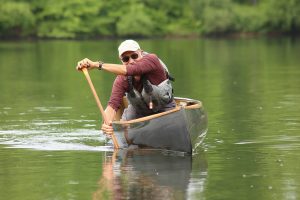
Yaw is the tendency of the canoe to turn away from the paddle side when executing a forward (or reverse) stroke. Yaw is an inefficiency that needs to be corrected for, usually by means of a J stroke or pry. Any correction slows the canoe, robbing you of momentum and is wasteful of the energy that you expended, to get it moving.
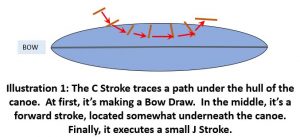
The C-stroke has long been taught as the preferred way to avoid yaw when starting from a standstill. Also, it is often suggested as a means to initiate an onside turn, either on its own or in conjunction with a hard J. The C-stroke is essentially a bow draw, appended to the beginning of a forward stroke and often, the blade is arced, slightly beneath the hull. (see illustration #1) While effective, it isn’t the most efficient way to get your canoe moving forward.
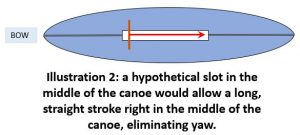 In a perfect world, we’d have a slot, through the bottom, along the centerline of the canoe, through which we could place the paddle. (see illustration #2) If the paddle were drawn straight back, shaft vertical and the blade perpendicular to the keel line, the canoe would move straight forward, without any yaw. Absent this hypothetical slot, we are forced to paddle offset, to one side or the other. The resulting offset force creates yaw.
In a perfect world, we’d have a slot, through the bottom, along the centerline of the canoe, through which we could place the paddle. (see illustration #2) If the paddle were drawn straight back, shaft vertical and the blade perpendicular to the keel line, the canoe would move straight forward, without any yaw. Absent this hypothetical slot, we are forced to paddle offset, to one side or the other. The resulting offset force creates yaw.
When teaching the forward stroke, we emphasize that the paddle shaft should be held vertical, meaning that the grip hand is extended out, past the gunwale, so that it is directly above the shaft hand. Bringing the grip hand inboard, even a little, moves the blade further away from the centerline and increases yaw. The further the blade moves away from the centerline, the more yaw that is created.
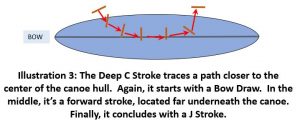 Rather than the standard C (see illustration #1) I suggest a deep C (see illustration #3). The deep C brings the entire blade beneath the canoe, closer to the centerline. Also, the face of the blade is kept perpendicular to the keel line (rather than following the arc) throughout a longer path. With practice, it is possible to reach the blade nearly beneath the centerline, approximating where it would be, IF that hypothetical centerline slot actually existed.
Rather than the standard C (see illustration #1) I suggest a deep C (see illustration #3). The deep C brings the entire blade beneath the canoe, closer to the centerline. Also, the face of the blade is kept perpendicular to the keel line (rather than following the arc) throughout a longer path. With practice, it is possible to reach the blade nearly beneath the centerline, approximating where it would be, IF that hypothetical centerline slot actually existed.
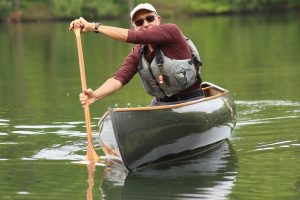
The deep C begins by leaning a bit forward and placing the paddle at the catch position, shaft vertical and just a few inches outboard of the gunwale. The grip arm/hand is then hyperextended so that it is outboard of the shaft hand. By the time the blade is fully submerged the blade is well under the hull. At the same time, the grip hand is rotated a bit so that the thumb is pointed slightly back. As you straighten up and draw the paddle back (relative to the hull) the grip hand straightens so that the blade is perpendicular to the keel-line. When the shaft reaches your knee, it’s time to let off on the power and carry through to a mild J, as far back toward the stern as you can comfortably reach.
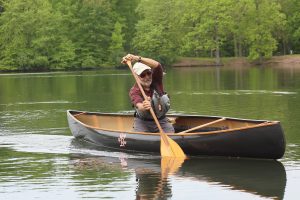 |
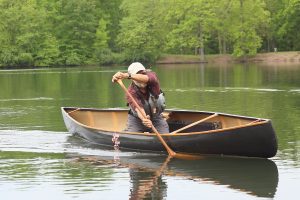 |
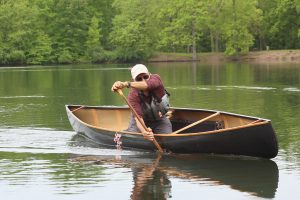 |
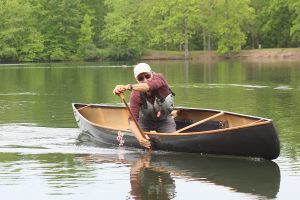 |
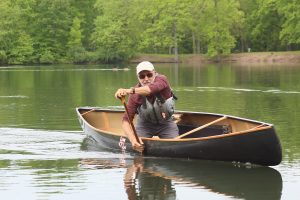 |
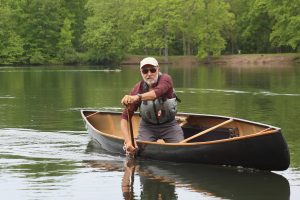 |
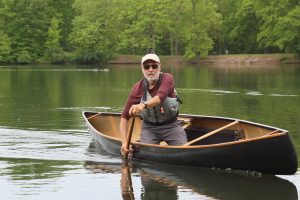 |
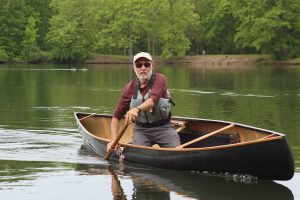 |
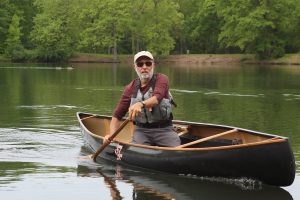 |
If your purpose is simply to begin forward travel with minimal yaw, a well-executed Deep C, with (or even without) a mild J correction may be all that is necessary. Alternatively, if your desire is to begin an onside turn, hold the J a bit longer and, if necessary, perform a second deep C.
The deep C applies considerably more forward thrust, beginning right at the catch than the standard C. That, combined with reduced yaw makes it a more efficient and effective way to begin your journey.
Here’s a Video, showing how it looks: MVI_9498.MOV
Useful references:
https://freestylecanoeing.com/jaded/